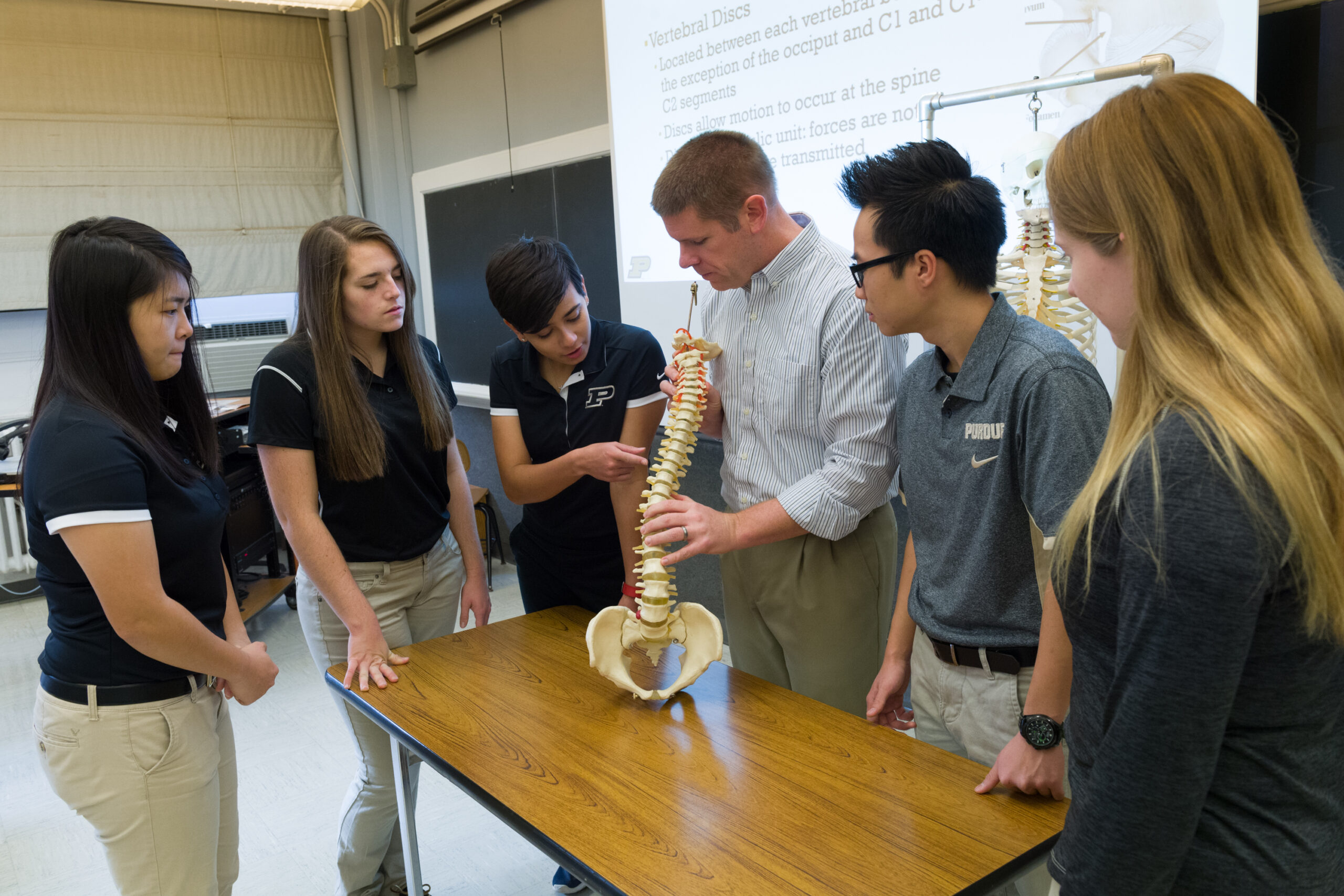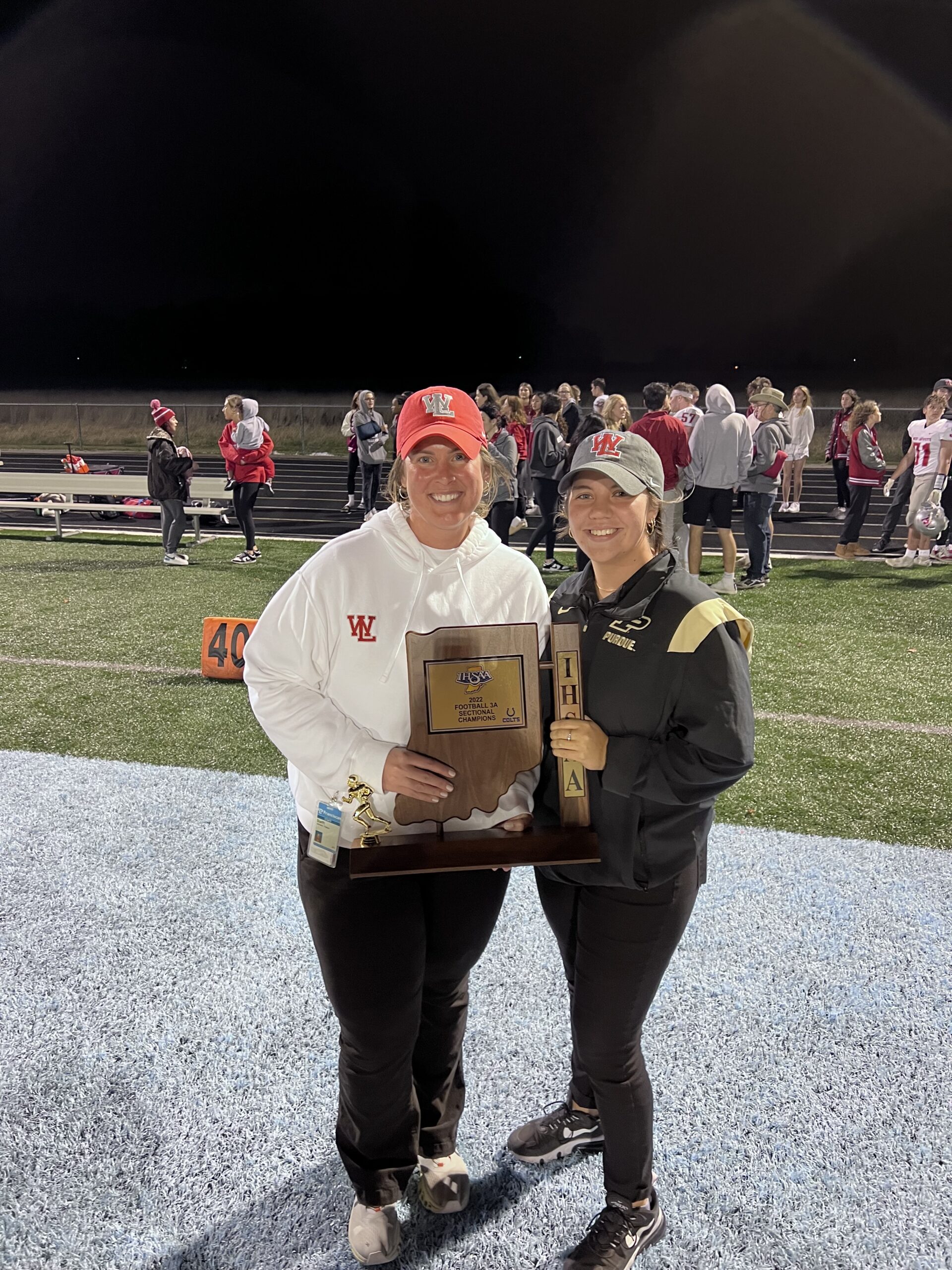Purdue Health and Kinesiology students catch on to new Sports Medicine concentration

Clinical Professor Scott Lawrance, middle-right, teaches some sports medicine students about spine vertebrae.
Written by: Tim Brouk, tbrouk@purdue.edu
The Purdue University Department of Health and Kinesiology (HK) positioned itself well to prepare its undergraduate students for careers in athletic training when the industry deemed professional athletic trainers must have master’s degrees in the field.
A sports medicine concentration was established in 2020 to keep the undergraduate program’s momentum in producing professional athletic trainers — and other health care professionals — on fields, courts and rinks around the nation.
The major exploded in enrollment in the 2022-23 academic year, growing from 20 to 122 students in just 12 months — a 510% increase. The success was due to fast-acting faculty members such as Clinical Professor Scott Lawrance and Department Head Tim Gavin. New courses were drawn up, and approvals were gathered, ensuring HK did not spend any time on the bench in preparing future athletic trainers and other related health care professionals.
“Sports medicine is an umbrella term. It is an area a lot of individuals practice within, and that’s one of the things we really want our undergraduate students to know and experience. They will be able to determine if they want to be an athletic trainer or (if) they want to maybe do something else,” Lawrance explained during a recent study abroad experience in Ireland with some of his students.
The new academic concentration still offers internships, study abroad programs and observational experience with multiple Purdue Athletics programs.
Lawrance and his fellow faculty also had to ensure the last cohort of athletic training undergraduates finished on time while welcoming the first cohort of athletic training graduate students, who will be poised for the job market with the new master’s degree requirement for the field. This was all while growing the new sports medicine program.
“We anticipate this concentration will continue to grow, and now we’re left with the good fortune of trying to ensure we can maintain a quality program for all of those students,” Lawrance said. “I’m confident we will.”
Drawing from decades of excellence
Purdue boasted one of the first athletic training programs in the nation. That history still helps the program attract top students today.
“Our legacy is deep,” Lawrance said. “We can trace our roots back 70 years; our first graduate was in 1953. Our profession started in 1950, so looking at it that way, we’ve been around since the beginning. I’ll never say we were the first, but we were among the first.”
The mantles of the sports medicine faculty also explain the surge in students. Lawrance and his colleagues are in the Indiana Athletic Trainers’ Association Hall of Fame and have earned national awards from the National Athletic Trainers Association.
The legacy of excellence is benefiting the new HK athletic training master’s degree, too, which was also revamped to meet the new field requirements. Students from around the globe have enrolled in the program, enthused to keep athletes ready to play worldwide.
Alumna’s sideline report

Paige Varga, a 2023 health and kinesiology alumna (right), poses for a picture during her athletic training internship at West Lafayette High School.
A 2023 HK alumna, Paige Varga was among the last of the athletic training undergraduate cohort. The reorganization of her former program looks promising to her as she begins her career as an athletic trainer for Atkins High School in Winston-Salem, North Carolina. The job is part of an outreach program with Atrium Health Wake Forest Baptist Medical Center.
Varga, who experienced similar work during her internship with West Lafayette High School athletics, believes the sports medicine concentration will prepare today’s undergrads for that master’s degree now required for athletic training. It will also guide them to the kind of athletic training job they would want to pursue. For example, after working with Purdue teams and the West Lafayette High School athletics department, Varga realized she preferred working in high school settings than collegiate.
“Having that ahead of time, at least an idea where you want to be, is huge, especially transitioning from a four-year program to a two-year (master’s) program because you have less time to decide. So, giving them that exposure early, I think, is a really helpful tool,” said Varga, who has been overseeing summer football workouts in her new job. “It gives these kids the hours they’ll need for a master’s program. It gives them the exposure to at least have an idea of what they like and what they don’t like about athletic training.”
Like the generations of Boilermaker athletic trainers before her, Varga credited her undergraduate experience in helping her realize her career passions.
“I actually didn’t really know who (athletic trainers) were and what they did until I got to college and met Scott (Lawrance),” Varga remembered. “A lot of times you only hear about athletic trainers when something catastrophic happens and they’re the responders. We are there for these athletes every single day. We know them better than a lot of people do. I don’t think there’s any other health profession that has a connection with their patients like we do.”
Loaded roster expected for 2023-24
This fall, HK is expected to welcome 125-130 new beginners to its ranks. Lawrance expects many of those to sign on for the growing sports medicine concentration. Most likely, not every one of those students will become an athletic trainer, but they will experience the profession through hands-on learning, training on and off the field, and expert knowledge about how to keep athletes — and those who cheer on the athletes — healthy.
“It really allows them to start seeing these different pieces and practices to give them a sense of where they would like to go with their careers,” Lawrance said. “It gives them a flavor of what a whole bunch of providers do in sports medicine.”